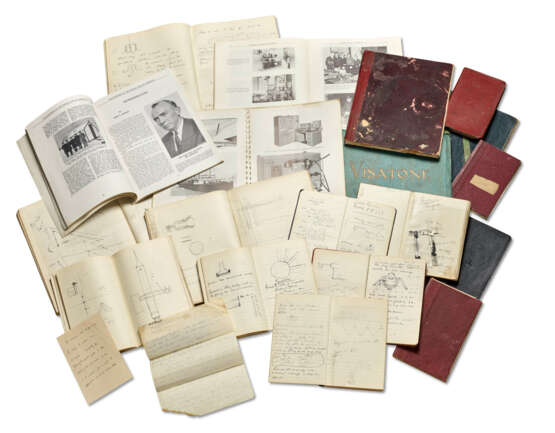ID 1109157
Los 355 | Henry Joseph Round (1881-1966)
Schätzwert
£ 6 000 – 9 000
The archive of H.J. Round, radio pioneer
In five large A4 archive boxes. Provenance: Sotheby's, 17 July 1984, lot 411.
The principal archival source for the work of radio pioneer H.J. Round, including an important series of early letters describing his work in the Marconi Company in the 1900s, his working notebooks, patents, photographs and more.
Comprising:
c.60 letters to his parents, c.1901-1912, written chiefly from Babylon, Long Island, Chicago and elsewhere in the U.S.A., many of considerable length (some incomplete), concerning the progress of experimental work in at early Marconi stations and Round’s contributions; and a series of early postcards, c. 1900s;
over thirty working notebooks, the earliest 1906, the majority 1940s-1950s, containing Round’s draft calculations, sketches and specifications for projects;
numerous other autograph and typescript drafts, notes, reports, and articles on Wireless Telegraphy, including a series of autobiographical reflections; a quantity of letters sent to him by correspondents;
photographs, including some of Marconi's early stations and apparatuses;
printed copies of 93 patent applications, including those for Direction Finding (1909), Valve Crystals (1910), Ring Modulators (1913), Multi-Grid Valves (1913) and Automatic Tuning (1921);
printed books, pamphlets, telegrams and other papers.
The radio engineer and inventor H.J. Round joined the Marconi Company in 1902 and was sent to the United States, where he worked at Babylon, Long Island. Here he experimented with dust-core tuning inductances and devised the elements of direction finding. In his spare time at this station he constructed one of the first arc radio telephones. He was recalled to England and became one of the corps d'élite working personally with Guglielmo Marconi. Having greatly improved the performance of the Clifden (Ireland) high power transatlantic transmitter, Round was sent to South America in 1912, where he performed an outstanding feat of engineering at two wireless stations on the upper reaches of the Amazon. On his return to England, Round immersed himself in the problems of valve amplification, and in 1913–14 patented important valve improvements. Round was seconded to military intelligence at the outbreak of war in 1914 and was entrusted with the setting up of a network of valved direction-finding (DF) stations covering the entire western front and the design of the first telephony transmitters and receivers for airborne use. For services to his country Round was awarded the Military Cross in 1918.
It was with his newly designed transmitting valves, the MT1 and MT2, that in March 1919 a telephony transmitter which he had installed at Ballybunion, Ireland, became the first European station to span the Atlantic with telephony. On 23 February 1920, on a wavelength of 2500 metres, the world's first wireless telephony news service was inaugurated, closely followed on 15 June by the first public broadcast entertainment, a recital by the Australian prima donna, Dame Nellie Melba. Two years later the concerts from ‘Two Emma Tock’ (2MT) at Writtle in Essex led to the establishment of station 2LO at Marconi House in the Strand, London. Again, the transmitter was designed by Round. This was the first station to be taken over by the BBC on its formation in November 1922. The artificial echo system and the Sykes-Round microphone were two of Round's many contributions to the early stages of the art of broadcasting. In parallel with this work, Round was redesigning the Marconi high-power station at Caernarfon, updating it from spark to valve transmission, using fifty-six MT2 valves. On 19 November 1921, using the new equipment, signals from this station were received in Australia. Appointed chief of the Marconi Research Group in 1921, Round's output was prolific. He designed valve receivers for ships and constructed the first batch of maritime valved transmitters. His book, The Shielded Four-Electrode Valve was published in 1927. He designed the ‘straight eight’ broadcast receiver; a gramophone recording system (licensed to the Vocalion Company); and a large-audience public address system, which was used to relay King George V's speech at the Wembley exhibitions. He devised a talking picture system which was licensed to Stoll (Visatone) for recording sound on film during the 1930s cinema boom.
In 1931 Round set up in private practice as a research consultant. He worked on asdic for the Admiralty between 1941 and 1950, and on echo sounding for the Marconi Company from 1950 onwards, inventing new magnetostrictive devices for use in the production of echo sounders; he also worked on the first permanently magnetized nickel transducers and the first belt recording system for echo sounders. He filed a total of 117 patent applications, the last of which was recorded in 1962 when he was eighty-one (Baker & Hance, ‘Round, Henry Joseph (1881–1966), radio engineer and inventor’, Oxford Dictionary of National Biography (2010)).
| Herkunftsort: | Vereinigte Staaten |
|---|
| Herkunftsort: | Vereinigte Staaten |
|---|
| Adresse der Versteigerung |
CHRISTIE'S 8 King Street, St. James's SW1Y 6QT London Vereinigtes Königreich | |||||
|---|---|---|---|---|---|---|
| Vorschau |
| |||||
| Telefon | +44 (0)20 7839 9060 | |||||
| Aufgeld | see on Website | |||||
| Nutzungsbedingungen | Nutzungsbedingungen |



